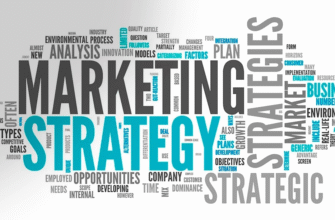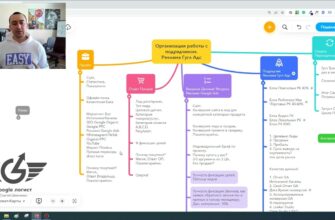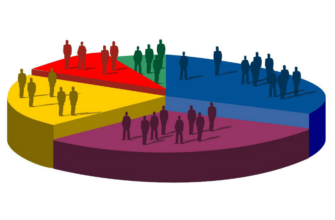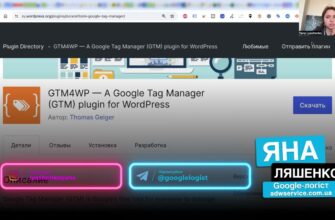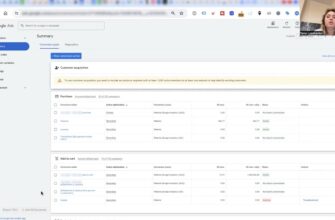- What is a target audience?
- Why is it important to correctly identify your target audience?
- Stay ahead of the competition
- Reduce advertising costs
- It’s better to get to know your customers
- Identify growth points
- Increase sales
- What are the different types of target audiences?
- Direct and indirect
- B2B and B2C
- Wide and narrow
- How to identify your target audience?
- 5W
- From the reverse
- From the product
- From the market
- What is a “customer profile” and how do you create one?
- Methods of segmenting the target audience
- Demographic
- Socio-economic
- Psychological
- Behavioral
- Geographical
- Common mistakes when defining the target audience for a business
- My product is suitable for everyone.
- Too narrow an audience
- No segmentation
- The financial capabilities of customers have not been taken into account.
- Incorrect offer
Defining your target audience (TA) is a key step in developing any business. Without a clear understanding of who will find your product or service interesting and useful, it is impossible to effectively build your marketing strategy and attract customers.
At the same time, many novice entrepreneurs make the mistake of trying to reach as wide an audience as possible. But imagine a professional fisherman — would he cast his net at random? No, he knows exactly what fish he wants to catch, where to find it, and what bait it will bite on. The same rule applies in business.
At the same time, even the world’s largest corporations, such as Apple and Microsoft, invest heavily in analyzing their target audience. They conduct large-scale market research before launching new products. And these investments pay off in full — this allows companies to better understand their customers’ desires and enables them to “hit the bull’s-eye” with their sales offers.
How many calls and sales will I get by ordering contextual advertising from you?
I need to calculate the conversion of my website Describe
the task
in the application
Calculate potential ad revenue Google
contextual advertising calculator
What is a target audience?

The target audience is the group of people or companies that are most likely to be interested in your product and willing to pay for it. All marketing efforts should be directed at these people — from contextual advertising, social media posts, and email newsletters to website content and offline activities.
The target audience brings together consumers with similar characteristics, desires, and behavior. This makes them ideal candidates for achieving your commercial goals. A deep understanding of the needs of your target audience is the key to the success of any business.
Please note! The target audience is not a static concept. Customer preferences and behavior can change from time to time under the influence of a wide variety of factors, from the emergence of new technologies to changes in the economy. Therefore, target audience analysis should be conducted regularly.
Why is it important to correctly identify your target audience?
Correctly identifying your business’s target audience is a truly important task that must be approached wisely. By focusing on a specific consumer segment, you can invest your funds as effectively as possible and minimize promotion costs. But a detailed study of your target audience also allows you to solve other problems.
Stay ahead of the competition
If you haven’t researched your potential target audience and developed an effective marketing strategy, every lost customer becomes profit for your competitors. A person interested in something specific will ultimately make a choice. And that choice may well not be in your favor if your marketing approach is lacking.
One of the key factors for success is identifying loyal consumers among your target audience and building long-term relationships with them. A few loyal people who place orders regularly will bring you much more profit than dozens of one-time buyers.
In addition, over time, satisfied customers become true advocates for your brand. They will recommend you to their friends and acquaintances, write positive reviews, and increase your company’s visibility. This, in turn, attracts new customers and increases conversion rates.
Reduce advertising costs
An advertising campaign without a clear plan and adequate audience targeting is a sure way to waste your budget and waste your time and nerves. Instead of “shooting at sparrows,” focus on finding people who are interested in your products. One well-aimed shot will bring much better results than a hundred blank ones.
For example, well-configured email marketing allows you to achieve a high percentage of opens and targeted actions with minimal investment. And personalized advertising on social media provides wide reach and excellent returns.
It’s better to get to know your customers
Imagine that you sell online courses that help students get into university. It is not enough to simply focus on potential students and their parents. You need to understand what subjects they study, their age, and their level of knowledge. The more detailed your audience segmentation, the more accurately you will be able to identify their pain points and desires.
For example, if you offer cybersecurity courses, it makes sense to focus on young people who are already interested in this topic or are studying in this field. These people are more likely to pay for your services.
Identify growth points
Business development is a direct path to increasing market share and profits, which is the natural goal of any entrepreneur. But where to start? How to find those very growth points? Answers to these questions can also be found through target audience analysis. Thus, even a small but loyal group of customers can become a driving force for promotion and a catalyst for sales.
Let’s say you make vegan ice cream without lactose. Your target audience is vegans and people with milk intolerance. Focus on this niche. Collect feedback and ideas. These messages will show you the way forward and help you improve your products.
Increase sales
Want to boost sales? Then it’s time to focus on the right target audience. The more accurately you know your customer, the higher the conversion rate of your marketing campaigns will be.
Perhaps your target audience is young web design professionals who actively use social media. Focus your efforts on this segment. Create relevant content for them, launch targeted advertising, and make personalized offers. Your chances of success will increase significantly.
How does it work? It’s simple. By attracting people who are already interested in your products, you significantly reduce the path from initial contact to purchase. People are more likely to respond to ads that meet their needs and interests. This means that not only does conversion increase, but overall sales increase as well.
What are the different types of target audiences?
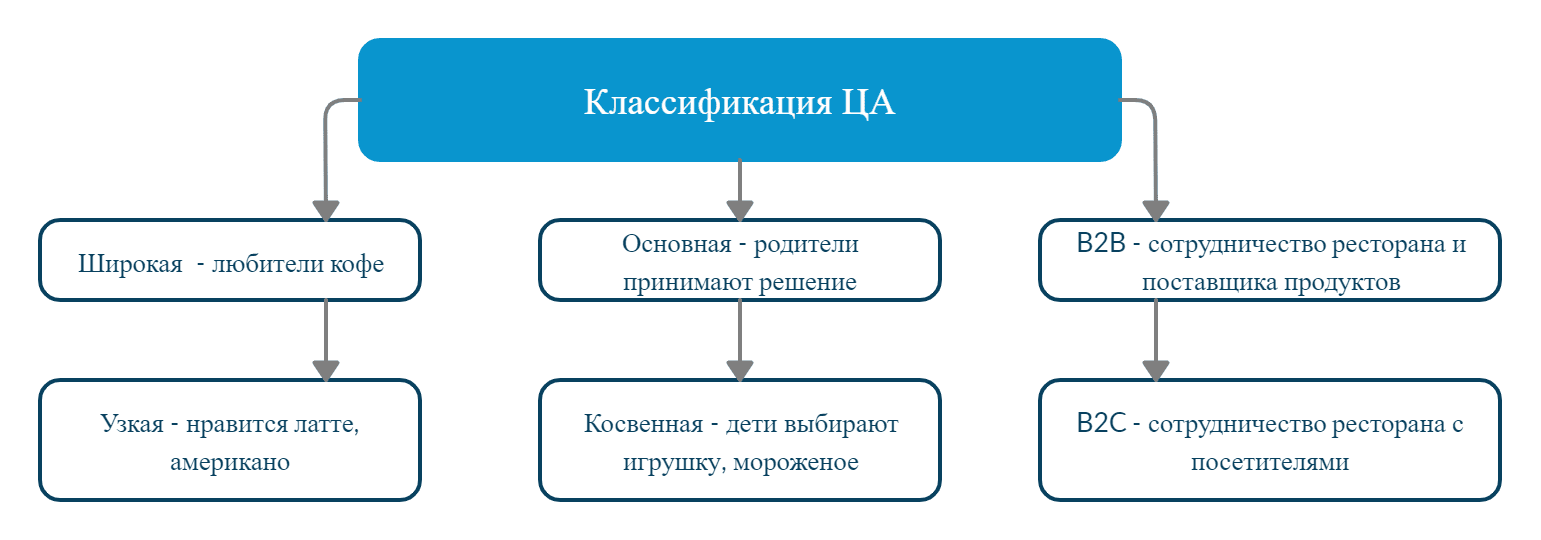
Any target audience is heterogeneous and can be segmented according to various parameters. Understanding these differences will help you create more personalized advertising campaigns and increase their effectiveness. Let’s take a look at the different types of target audiences that can be identified.
Direct and indirect
This is the main division of the target audience for a business, which has a significant impact on marketing strategy. The primary audience is directly interested in the product, and it is this audience that allocates money for it and makes the decision to purchase. The secondary audience, although it may have a direct interest in the product, does not make the decision.
For example, a child really wants a new Lego set that is sold in your online store. But in the end, it will be the parents who buy it. This means that children are the indirect audience, while parents are the main audience. And although the hypothetical toy factory focuses primarily on children (colorful advertising, attractive packaging), the decisive factor will be the approval of the parents.
Therefore, marketers will have to take into account the preferences of both groups. It is important to instill in children a desire to obtain a particular toy, while showing parents its educational value, safety, and brand reliability. Successful promotion should influence both the primary and indirect target audiences, albeit using different methods.
Of course, it is often the case that the buyer and the consumer are one and the same person. For example, when it comes to anti-aging cosmetics, a woman over 50 will want an anti-wrinkle cream herself and will buy it accordingly. There is no indirect component here. But in many areas, the division into primary and indirect target audiences is the key to increasing the effectiveness of an advertising campaign.
B2B and B2C
Another segmentation criterion is the type of customers you work with. There are two main categories here: B2B (business-to-business) and B2C (business-to-consumer).
B2B companies focus on working with other organizations. These are usually suppliers of raw materials, equipment, software, and business services. Working with them has its own unique characteristics:
- Procurement decisions are made not by one person, but by a group of responsible individuals, often with the involvement of experts.
- Quality and reliability of services are paramount, as the effectiveness of business processes depends on them.
- Companies are willing to invest significant funds, but in return they expect an individual approach and high-quality service.
- Brand reputation and market experience are of great importance.
- Relationships with B2B are usually long-term.
The B2C segment focuses on end consumers—individuals who purchase items for personal use. To attract such customers, consider the following:
- Buyers often make spontaneous decisions based on reviews and recommendations on the internet.
- Advertising should encourage quick purchases by appealing to emotions and basic needs (comfort, status, self-expression).
- B2C preferences change in line with trends, so it is necessary to keep your finger on the pulse and adapt your marketing.
- Many factors influence the choice, from functionality to appearance and fashion.
Find out what type your target audience belongs to. If you work with both businesses and individuals, adapt your marketing tools to each segment.
Wide and narrow
A broad audience includes all potential consumers who may be interested in your product. Let’s say you sell organic food. Then, in a broad sense, your target audience is everyone who strives for a healthy lifestyle.
However, working with such a large and diverse group is not always effective. After all, among healthy lifestyle enthusiasts there are young athletes, pregnant women, and people with chronic diseases. They have different needs, incomes, and lifestyles. It is unlikely that a single universal advertising message will be able to reach them all.
Therefore, it is better to divide a broad target audience into narrower subcategories. This allows you to gain a deeper understanding of your customers and address them with personalized messages. For example, the same organic food seller could identify the following additional groups:
- Young mothers who choose the best for their children;
- Athletes who need “clean” nutrition for recovery;
- Office workers who care about their health and figure;
- Vegetarians and vegans with specific requests.
Within these narrow segments, it is easier to find the right insights, triggers, and arguments. Create advertising messages and USPs that will resonate with each specific group. This way, you will gain a truly loyal and engaged audience.
How to identify your target audience?
Intuition and general ideas are not enough in this case. A systematic approach based on data collection and analysis is needed. Marketers have developed proven methods that will help you create a portrait of your ideal customer. Next, we will look at how to understand who your target audience is and what methods exist for doing so.
5W
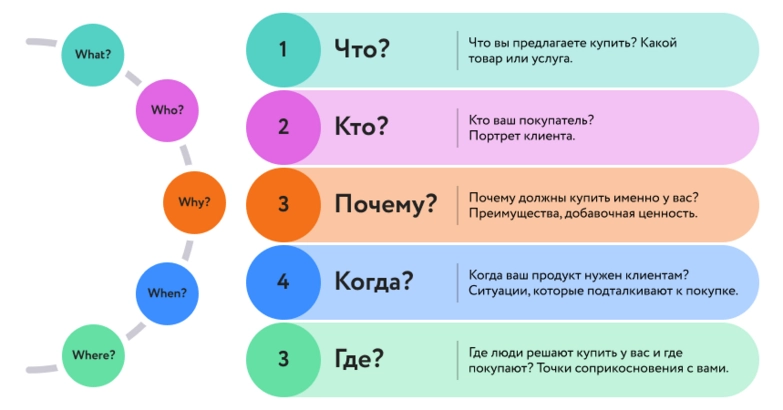
One of the simplest and most effective methods for identifying your target audience is the 5W method developed by Mark Sherrington. It involves answering just five key questions about your product and potential customers:
- What? Clearly describe what exactly you are offering. Perhaps it is the product itself, a service, or a subscription.
- Who? Create a detailed portrait of your ideal customer. Include socio-demographic characteristics (gender, age, income level, field of activity), interests, values, and lifestyle.
- Why? Specify what needs and desires your product should satisfy. What motivates people to buy it? Saving time, health concerns, status, unique experiences?
- When? Think about the situations in which your services are needed. For example, a product may be needed regularly or only at certain times of the year, for special occasions, or purchased spontaneously.
- Where? Find out where your potential customers look for information and place orders — for example, on a website, in an offline store, on a marketplace, or on social media.
The answers to these five questions will give you a clear idea of who to sell to, what to sell, and how to sell it. With this approach, your customers will feel that you truly understand and value them. This is the key to long-lasting and mutually beneficial relationships.
From the reverse
The essence of this method is to start from the end result that your customer should achieve. Begin with a clear description of the desired outcome. What exactly will a person get by using your product? Let’s say you sell an online English language course. The result is fluency in the language at a conversational level.
Next, imagine the path that a person will take to reach this goal. In our example, this includes registering for the course, completing lessons, doing homework, communicating with the teacher, and taking the final test. Think about what obstacles will arise at each stage and how to overcome them.
How many calls and sales will I get by ordering contextual advertising from you?
I need to calculate the conversion of my website Describe
the task
in the application
Calculate potential ad revenue Google
contextual advertising calculator
The next step is to identify the needs and motivations that will drive a person to follow this path to the end. In the case of English, this could be the desire to find a high-paying job, move abroad, travel freely, or watch films in their original language.
Based on these needs, create a portrait of your audience. What kind of people are most likely to want the promised result? Consider socio-demographic factors, life circumstances, and interests. In our example, the target audience could be:
- University students and graduates who need English for their studies and careers;
- Specialists who want to work in international companies;
- Travelers who are tired of language barriers;
- Fans of foreign pop culture.
Based on these portraits, create several marketing campaign options. Test different approaches on small groups. Analyze the response and draw conclusions about which potential customers are most receptive to your product.
This approach will help weed out people who are not interested in your offer or cannot afford it. The “reverse” method is particularly good for products with a long purchase decision cycle.
From the product
Another method for determining your target audience is based on the characteristics of the product itself. If it has features that set it apart from competitors, use them as a hook to attract buyers. Here is a step-by-step plan of action:
- Collect data on similar products. Conduct a comparative analysis and identify the strengths and weaknesses of your offer. This will help you find your USP — unique selling proposition.
- Survey existing customers to better understand their needs, expectations, and other qualities. Find out what attracts them to your product and how they use it.
- Analyze the product from a marketing perspective. Its main advantages and possible disadvantages are important here. Which promotion channels will perform better? What challenges will you face?
- Mentally divide potential consumers into three groups: people who already buy the product, those who do not yet buy it but may be interested, and those who will definitely not become your customers. Focus on the first two categories.
- Describe the second group in as much detail as possible. Create detailed portraits of these people.
- Think through specific marketing activities that will help attract your target audience segments. These could include advertising campaigns, special offers, or loyalty programs.
From the market
The last option is to base your decision on the market situation and the actions of your competitors. To do this:
- Analyze the market. Find existing research or commission your own. Identify your competitors, their target audience, the advantages they emphasize in their communications, and the promotion channels they use.
- Communicate with customers. Conduct surveys among those who already buy from you and those who are part of your potential target audience. Ask what motivates them to place an order, what factors play a fundamental role in their choice, and on which platforms they prefer to interact with the brand.
- Study your competitors. You need to analyze what benefits they offer in their USP. This will help you find vacant niches and come up with your own unique selling points.
- Formulate hypotheses about your target audience. Based on the information you have gathered, make assumptions about who will be interested in the product. Create a detailed profile of these people, describing their characteristics, needs, concerns, and expectations.
Important! In any case, test a variety of approaches in practice and evaluate the results. Monitor the reaction of each audience segment and adjust your approach if necessary. Gradually, you will identify the consumers for whom your solution is most suitable.
What is a “customer profile” and how do you create one?
A customer profile (or “persona”) is a detailed description of the most typical representative of your target audience. It helps you understand who exactly you are selling your product to and learn about their characteristics. To create an accurate profile, you will need to collect and analyze the following information:
- Demographics. Gender, age, country of residence, education, profession, total income. This is basic data that allows us to outline the general contours.
- Psychological factors. These include life values, interests, hobbies, fears and concerns, and motivation. You will need to understand the inner world of the future buyer and determine what motivates them.
- Behavioral characteristics. How a person makes decisions about placing orders, where they look for information, what communication channels they use, how they spend their free time. This data will suggest how and where it is best to interact with them.
- Problems and “pain points.” What difficulties does the customer face, what unresolved issues do they have, what prevents them from achieving their goals? Your solution should address these needs.
- Objections. These are things that may prevent a customer from buying your product. Find out what doubts they have and how they evaluate alternatives. Addressing these issues will increase conversion rates.
Based on the information you have gathered, create a detailed description of your ideal customer. Give them a name, describe their life, interests, goals, and problems. Here is an example:
Olga, 42, lives in Ivano-Frankivsk. She works as an English tutor. She is married and has two teenage children. She leads an active lifestyle and loves to travel. She is looking for comfortable and practical everyday clothing and footwear at affordable prices. She pays attention to natural materials and quality. She doesn’t have time to spend a long time choosing and values good service.
With this description, it is much easier to create the perfect USP specifically for this buyer. You can emphasize delivery speed on your website and highlight the comfort of a new pair of sneakers or leather jacket in your advertisements. And, of course, these requirements can be implemented in practice by refining your product range and website.
Methods of segmenting the target audience

You can segment your audience based on a variety of criteria. The more precisely you define subgroups, the easier it will be to create relevant USPs for them and convey your ideas. Of course, it is not advisable to create too many small subgroups, as this will complicate the process.
It is best to divide your target audience into 3-7 large segments, united by key characteristics. Next, we will look at the main methods and parameters of segmentation. Use them to gain a deeper understanding of your customers and build long-term relationships with them.
Demographic
One of the most common and straightforward ways to divide your target audience into subgroups. This method takes into account gender, age, income, education level, marital status, field of activity, etc. Knowing these characteristics, you can draw conclusions about the lifestyle, interests, and needs of different audience segments.
For example, when promoting children’s products, it makes sense to target women aged 25-40, who are the main buyers of baby products. When advertising expensive cars, it is better to focus on men over 35 with high-paying jobs.
Demographics also suggest where to look for a particular target audience. Young people are more active on social media and messaging apps, while the older generation tends to watch TV and read newspapers more often. Students spend a lot of time at universities and cafes, while office workers spend more time in business centers and on public transport.
However, this method has a number of limitations. Demographic data only provides a general description of a person and quickly becomes outdated. In addition, people of the same gender and age often have different tastes and worldviews. Therefore, it is better to supplement demographics with other criteria.
For example, you sell designer clothing. Your customers include 20-year-old students and 40-year-old businesswomen. Although they differ greatly in age and occupation, they are united by their love of fashion, their desire to stand out, and their willingness to spend money on shopping.
Socio-economic
The method takes into account income, profession, and field of activity. These parameters directly influence customers’ purchasing power and expectations. It is obvious that people with different incomes react differently to the same prices and offers. If your target audience is students and young professionals, they will be interested in promotions, discounts, and bonus programs. Wealthy businesspeople are more attracted to brand prestige, exclusivity, and high-quality service.
Imagine that you own a beauty salon. Customers with a monthly income of up to 20,000 hryvnia are likely to be interested in standard procedures at reasonable prices and regular discounts. People with an income of over 50,000 can be offered image services, the work of top masters, and VIP programs.
Psychological
Knowing a person’s psychotype, you can choose the right triggers that will push them to buy. Let’s say you are targeting young mothers. Some of them are conservative, preferring tried-and-tested brands and afraid to experiment. Others, on the contrary, follow trends, love new products, and are ready to try unknown brands. For the former, it is better to focus on quality, safety, and tradition. The latter will be attracted by innovation, bright design, and unusual product features.
But how can you learn about your customers’ psychological characteristics? Observe their behavior on social media, analyze their interaction history, and gather feedback through surveys and interviews.
Modern analytics tools, such as Google Analytics, allow you to identify a person’s interests and preferences based on their digital footprint. Tools such as Facebook Pixel or Brandwatch can also help. They will help you find out what content your target audience interacts with and how.
Behavioral
This method helps analyze how people behave when choosing and purchasing products. Such segmentation takes into account order history and frequency, average check amount, channels used to interact with the brand, response to promotions, etc.
This information helps personalize marketing at all stages of the funnel. For example, you see that a person often buys from you, but has recently started visiting your competitors. It’s time to remind them about yourself, send them an exclusive discount or an invitation to a private sale. To regain their loyalty and not lose them completely.
Loyal customers and brand advocates deserve special attention. These are people who regularly buy from you, participate in bonus programs, write good reviews, and recommend you to their friends. They should definitely be encouraged and retained. Come up with special offers, gifts, and a special loyalty program for them. Make them feel valued and exclusive.
Geographical
This segmentation takes into account where your potential customers are located—in which city, region, or country. This information is invaluable for businesses focused on the local market. Take, for example, a chain of pizzerias in Lviv. Obviously, it makes sense to promote it to the residents of this city, rather than to the whole of Ukraine.
Knowing delivery addresses or areas where people come to eat, you can give them personalized offers. For example, “Order two pizzas in the next hour and get a free drink” or “Free delivery to your area today.”
Remember! Even within the same city, people can vary greatly in terms of income, lifestyle, and tastes. Residents of the city center and suburbs, residents of elite residential complexes and typical high-rise buildings are completely different segments with different interests. Therefore, don’t limit yourself to formal geography; look at your customers comprehensively and from different angles.
Common mistakes when defining the target audience for a business
Even if you know your niche well, it is not always possible to correctly identify your target audience. It would seem that you know your customer perfectly well. But some misconceptions are so subtle that they are difficult to recognize in time. And the price of a mistake is high — wasted budgets, time, and effort. Below, we will discuss the most common mistakes and suggest how to avoid them.
My product is suitable for everyone.
This is a dangerous illusion that leads to a waste of resources and a lack of results. The desire to reach the widest possible audience is understandable. It seems that the more potential customers there are, the higher the sales will be. But in practice, a universal approach does not work well. Advertising texts aimed at absolutely everyone often fail to appeal to anyone.
The solution is to narrow your focus and clearly define your target audience. Specific positioning aimed at “your” customer will work much more effectively than vague wording. Think about who will benefit most from your product. Focus on the needs, pains, and desires of this group.
Too narrow an audience
Excessive narrowing of your target audience is the other extreme that should be avoided. When you focus on a specific segment, such as “IT specialists from Dnipro who enjoy lattes with coconut milk,” you risk attracting insufficient traffic.
Breaking down your target audience into a bunch of small subgroups will need a separate analysis, USP, and even strategy for each one. This takes a lot of time and resources. Focus on 1-3 key segments that will bring in the most profit.
Of course, it’s easy to get carried away when creating a portrait of your ideal audience. But it’s important to stop in time and cut out unnecessary details that won’t be useful in practice. Focus on the specific behavioral characteristics of the customer during the purchasing process.
No segmentation
Another common mistake is a general definition of the target audience, such as “male athletes aged 20-50.” This formulation is of little use, because within a large group there may be individuals with completely different behavior patterns, concerns, and motivations.
To fix this problem, divide your broad audience into narrow segments based on criteria that are important to you. Even a basic division into 3-5 subgroups will increase the effectiveness of communication and the level of trust in your brand.
The financial capabilities of customers have not been taken into account.
It often happens that a business has many fans, but they don’t buy anything. Creative startups are particularly guilty of this. It seems that the audience is active — they like and comment. But there are no sales. Imagine that these subscribers are design students. They like your style, but they can’t afford furniture for $2,000.
What should you do? Assess the target audience’s ability to pay and willingness to buy. If the audience is not solvent, change either the product or the target audience. Focus on people who are ready to buy, not just those who are interested.
Incorrect offer
What if you are addressing the right audience, but with the wrong offer? People see the right store, the right product, but it doesn’t appeal to them. Most likely, you missed the mark with your communication.
Carefully study your audience. Observe, analyze behavior, and survey customers. Choose the right words, arguments, and communication channels. Test different hypotheses until you find a working option.


